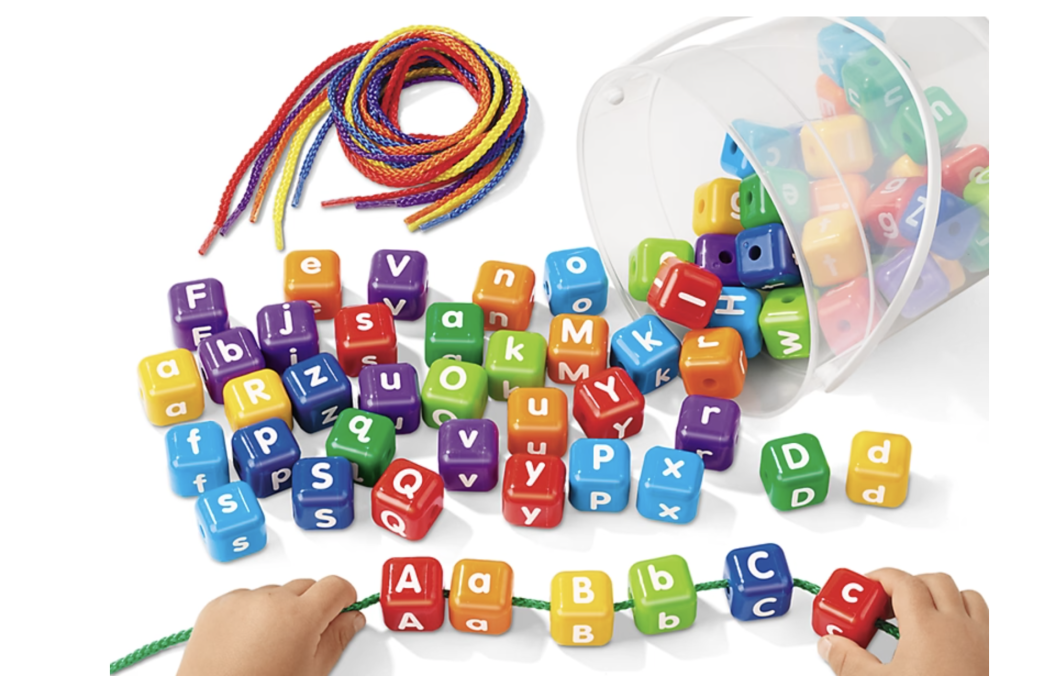Now that it is January and I have a bunch of kids heading to kindergarten in the fall, I shift goals and expectations in order prepare them for the transition from preschool to big kid school. Many of the schools in NYC are more social emotional based and not necessarily focused on the academics. While that is developmentally appropriate, it doesn’t always prepare them for the increased expectations that are required from day 1 in both public and private schools. My main goal with my older preschoolers, is to make sure that they have the basic handwriting skills so they are confident when they move on to a new school. In this post, I am going to share some toys that will make learning how to identify and write letters fun and motivating and some hands-on activities you can do with your preschoolers that will also help them learn. I am a big fan of multi-sensory learning with children this age and not just sitting down with paper and pencils, especially for the kids on my caseload who have fine motor, grasping and manipulation skill delays.
First of all, one of the things I strongly encourage is that you must make sure that your child can consistently identify all the letters of the alphabet before having them learn how to write them. Letters need to have meaning before learning how to write them. For example, when teaching children letters of the alphabet, always pair the letter with an object, person or place with the same letter….M is for Mickey Mouse, V is for Vivian, etc.. This helps with children being able to generalize letters. Secondly, it’s important to make learning fun so kids are motivated to do the hard work. For some kids, flashcards and drilling work for learning but many of the kids I work with respond to a more hands-0n approach. Lastly, if you have a child who is really struggling, be sure to celebrate as they learn. Get stickers, a special snack or the promise of special time with their grownups after they spend time working on learning or writing their letters. Below, I share some of my favorite handwriting toys, apps and activities that you can do at home with your little ones.
Toys for Learning Letters
I have tried to include a bunch of different kinds of toys that will help children learn how to identify, match and eventually, learn how to write letters. As previously mentioned, I am a big fan of using a multi-sensory approach to learning letters and how to write them. This kind of approach can decrease the stress and intimidation that sometimes comes along with learning any kind of new skill, including identifying and writing letters. When you provide kids with different materials and toys, you increase their curiosity and motivation to try things that are typically more challenging for them.
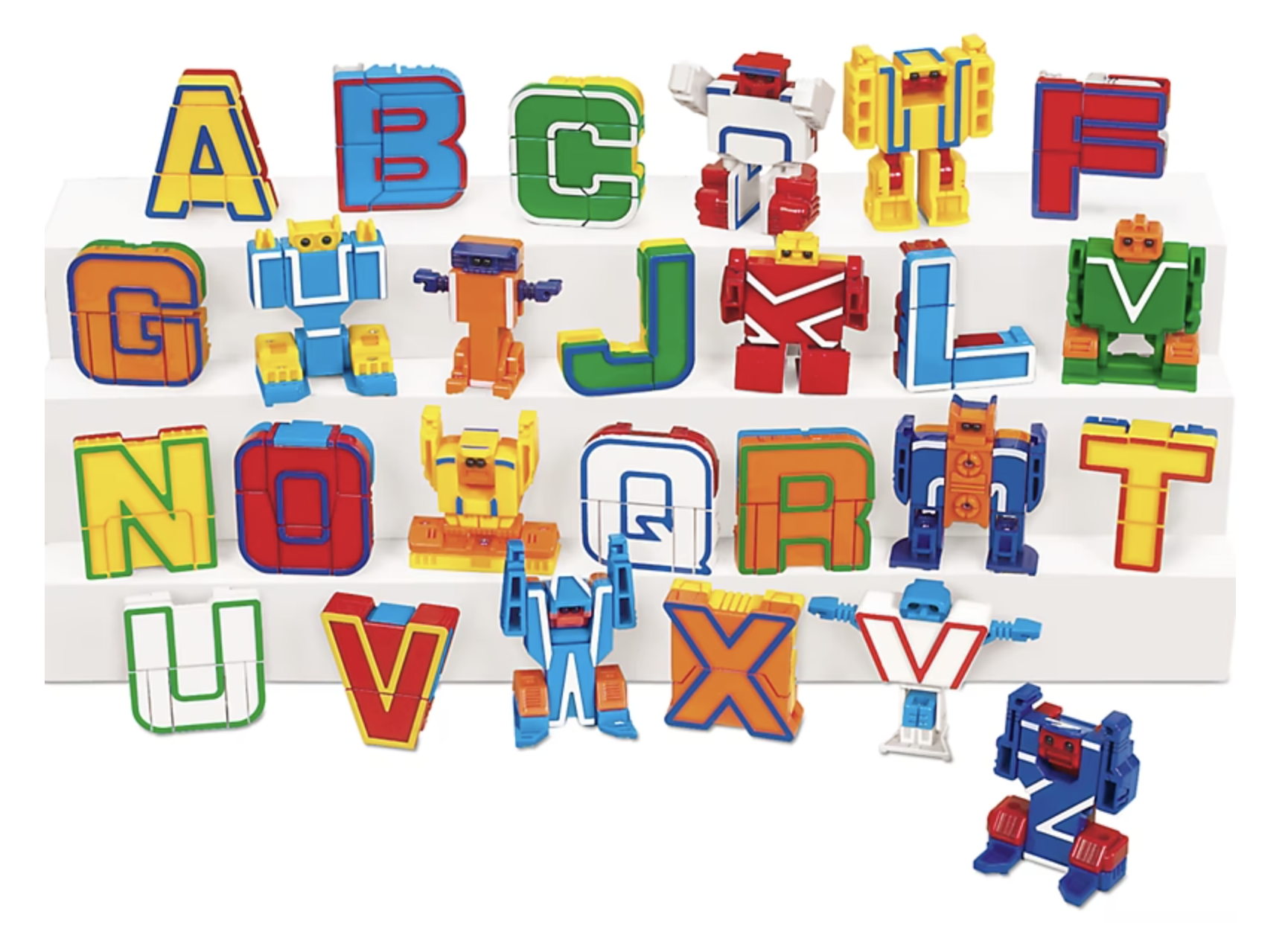
LakeShore AlphaBots-these are one of the most loved alphabet toys that I have had during my career and I love how they work on so much more than just learning about letters. With a few twists and turns, eachof the letters turns into a unique robot which is great for working on improving fine motor, grasping and manipulation skills. They are also great for working on improving organizational skills and motor planning skills.
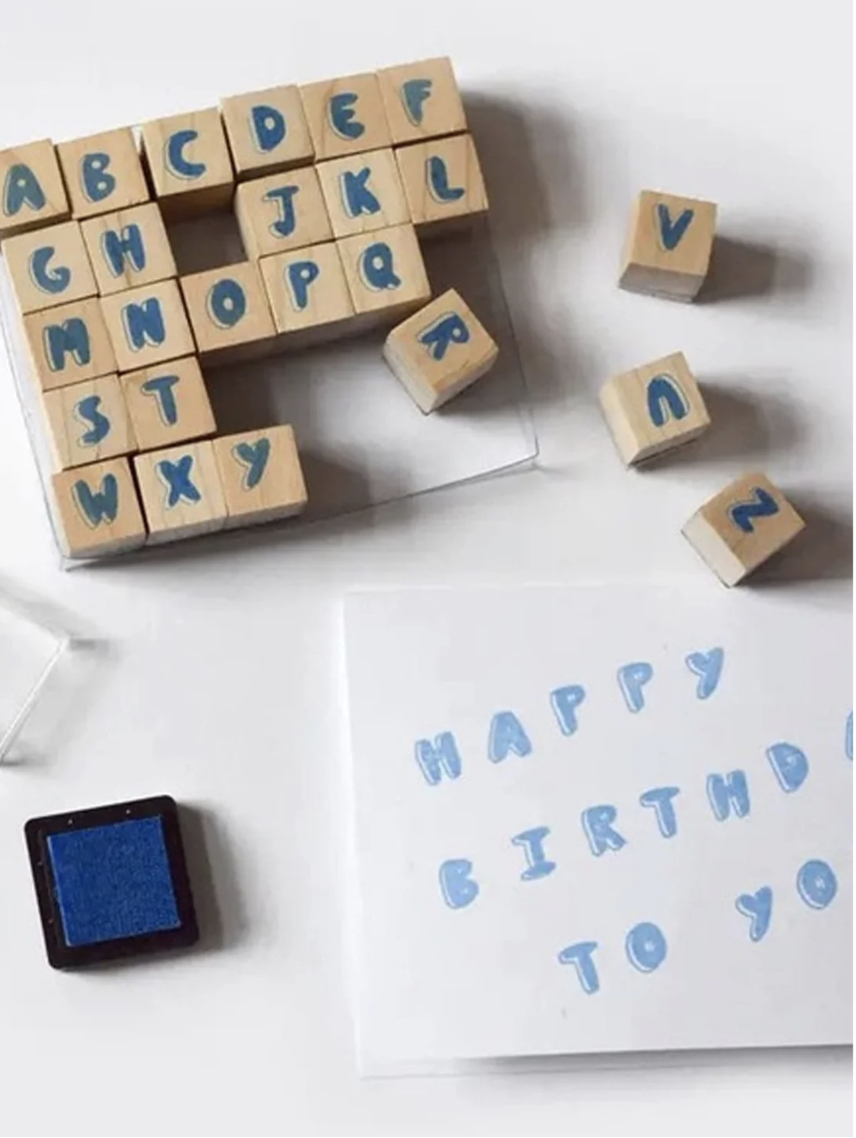 Alphabet Stamps-there are so many fun ways that you can use these alphabet stamps when teaching kids about letters. Not only will it encourage letter recognition and letter matching, it can work on a variety of visual skills such as visual tracking, visual scanning and hand-eye coordination. Some of the things you can do with alphabet stamps are as follows:
Alphabet Stamps-there are so many fun ways that you can use these alphabet stamps when teaching kids about letters. Not only will it encourage letter recognition and letter matching, it can work on a variety of visual skills such as visual tracking, visual scanning and hand-eye coordination. Some of the things you can do with alphabet stamps are as follows:
*write all of the letters scattered on a piece of paper and have them match each stamp to the correct letter
*if your child already knows the letters and are beginning to read or learn how to write sight words, write out a bunch of words with a letter missing and use the stamps to fill in the missing letters
*dump the stamps into a bowl and have them look through and find the letters in alphabetical order
 Float and Find Alphabet Bubbles-I am a big fan of using bath time as an opportunity to build in some therapy carryover because kids are often more relaxed, calm and open to trying challenging things during this time. This set from the always reliable LakeShore Learning includes 26 watertight plastic bubbles that have an upper and lowercase letter on one side and a picture of an object that starts with that letter on the other. What I like about this set is that you can use
Float and Find Alphabet Bubbles-I am a big fan of using bath time as an opportunity to build in some therapy carryover because kids are often more relaxed, calm and open to trying challenging things during this time. This set from the always reliable LakeShore Learning includes 26 watertight plastic bubbles that have an upper and lowercase letter on one side and a picture of an object that starts with that letter on the other. What I like about this set is that you can use
it in a variety of ways depending on what your child is working on. If you have a younger child just starting the literacy journey, you can make sure that all the bubbles are picture side up and have them find the object and then turn them over and look at the letter. If you have a kid who already knows their letters, flip it to the other side and make them find a letter that you call out.
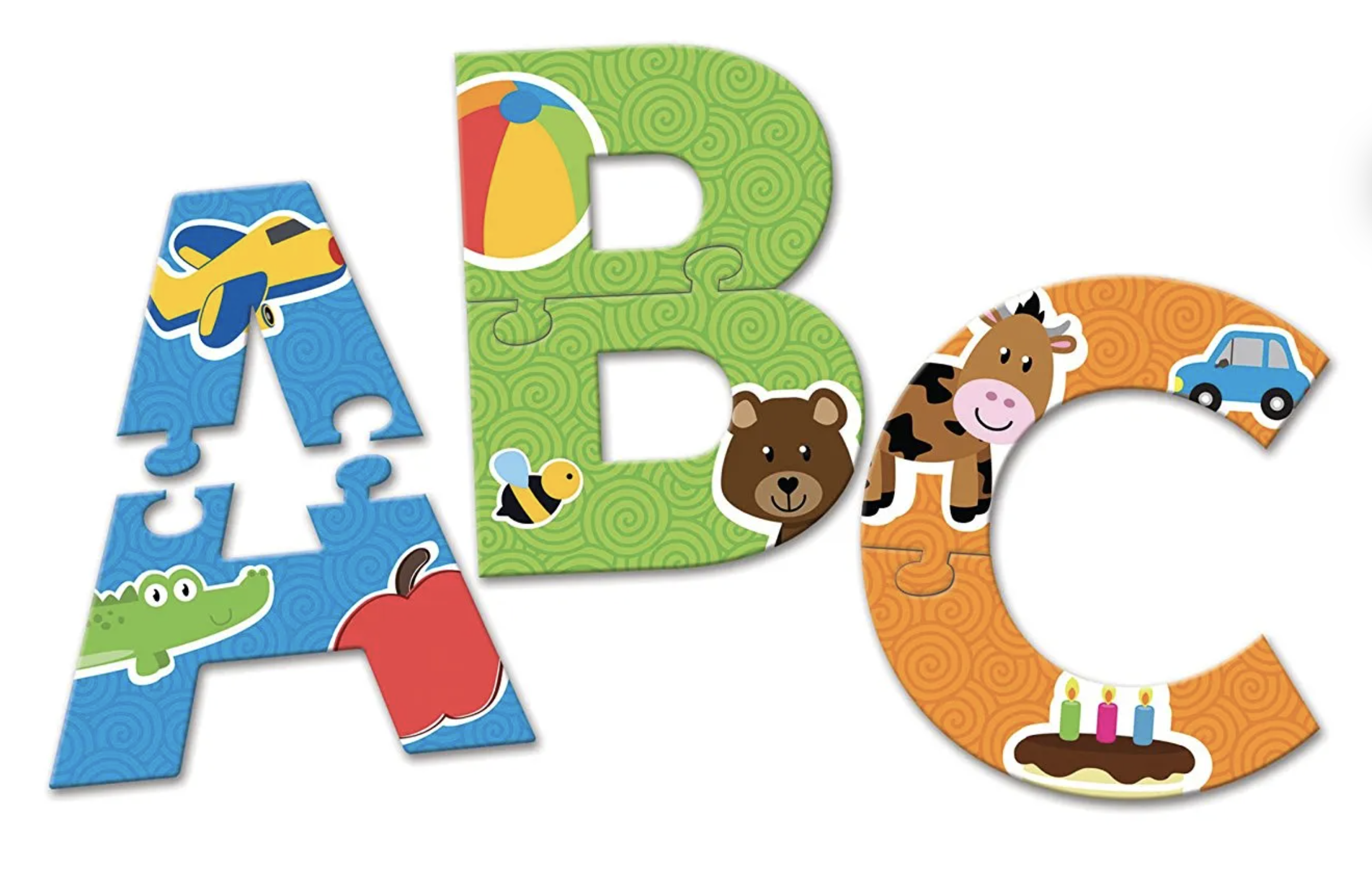 Alphabet Puzzle Cards-these puzzle cards are great for teaching kids their uppercase letters. Each letter comes in 2 pieces and has pictures of different objects that start with the corresponding letter. Additionally, they are great for working on improving fine motor, grasping and manipulation skills, improves bilateral and hand-eye coordination and improves visual motor and visual perceptual skills. These are small, lightweight and great for keeping kids learning and entertained while on-the-go.
Alphabet Puzzle Cards-these puzzle cards are great for teaching kids their uppercase letters. Each letter comes in 2 pieces and has pictures of different objects that start with the corresponding letter. Additionally, they are great for working on improving fine motor, grasping and manipulation skills, improves bilateral and hand-eye coordination and improves visual motor and visual perceptual skills. These are small, lightweight and great for keeping kids learning and entertained while on-the-go.
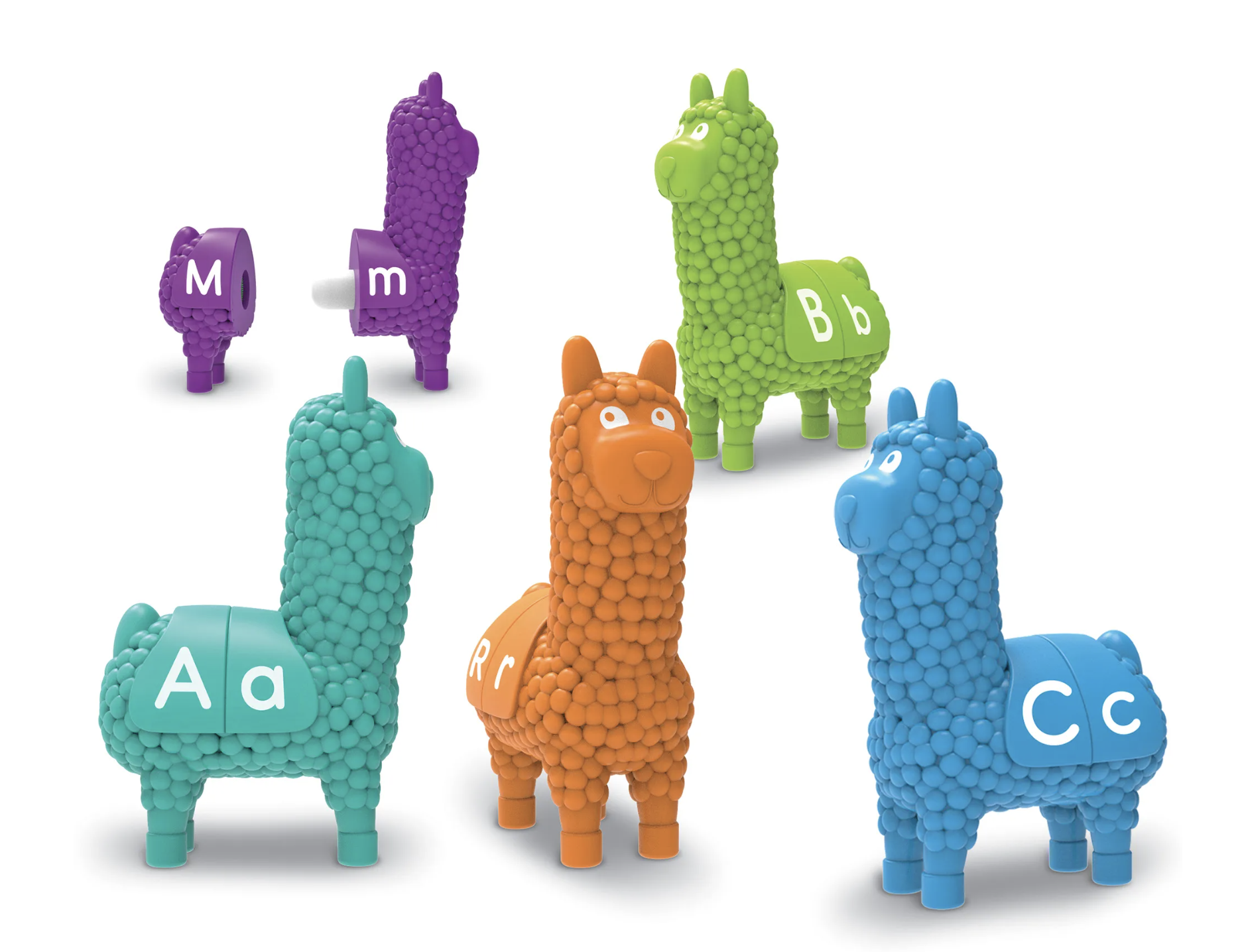
Snap-n-Learn Letter Llamas-Learning Resources has the best selection of matching alphabet matching toys out there. We have so many of them at my gym but I think my personal favorite are these adorable Llamas. Kids not only work on letter identification and matching, they are working on learning colors, improving grasping and manipulation skills, improving hand-eye and bilateral coordination skills and improving visual motor and perceptual skills. My kids love lining them up in a line and watching them fall over like dominoes when they are all finished matching them. An added challenge you can include for older kids and those that know their letters are have them tell you a name or an object that starts with that letter.
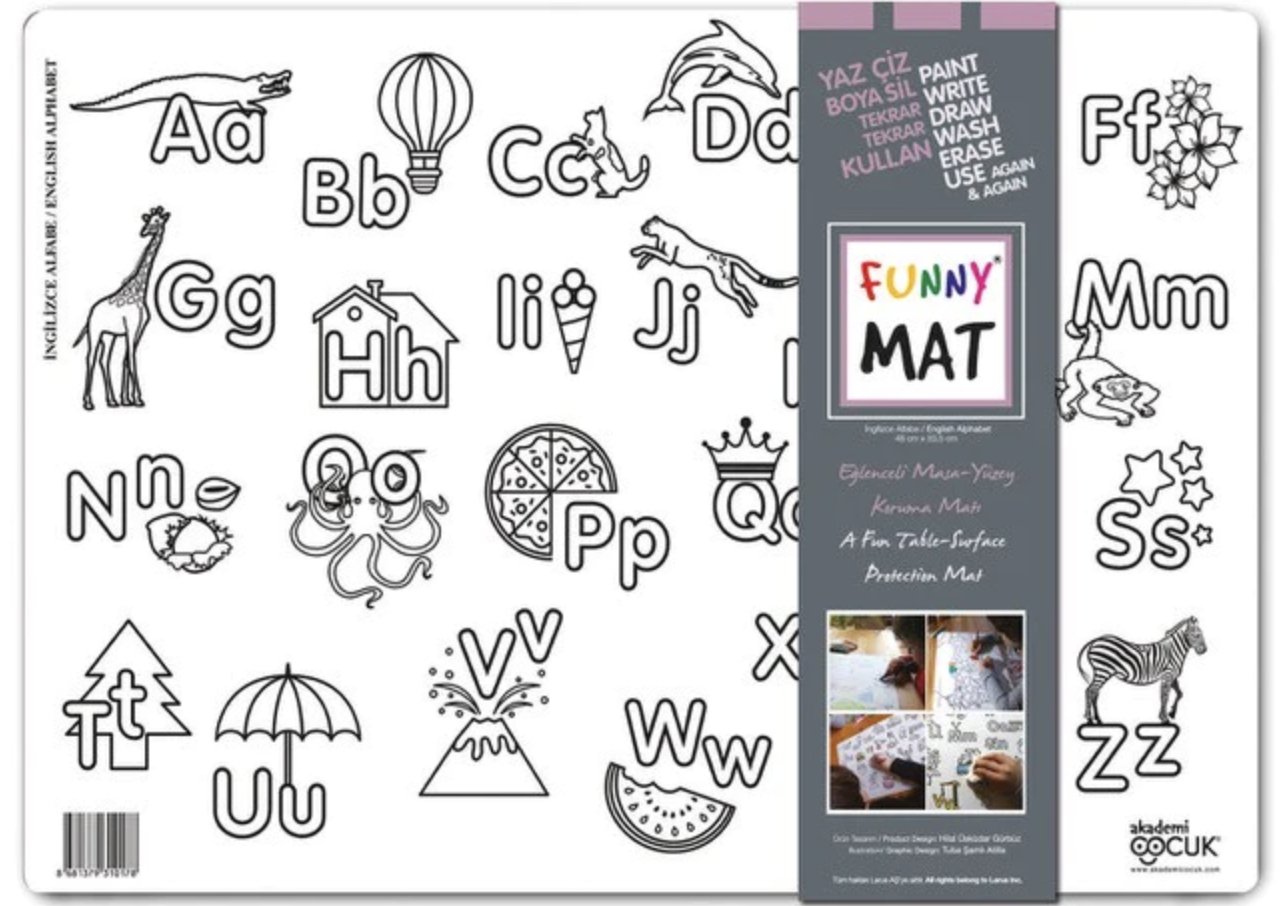
Funny Mat Alphabet-I love these series of coloring placemats because they are good for keeping kids learning at home, while traveling or when out to eat. This placemat can be colored over and over again and can be easily cleaned. The mat has all of the upper and lowercase letters with a picture of something that starts with that letter and all can be colored. This is a great way to learn about letters while also working on developing fine motor, grasping and manipulation skills, encouraging visual skills such of hand-eye coordination and visual motor skills and great for working on focus, attention and organizational skills. As the kids master the alphabet, you can challenge them by giving them the name of an object (not pictured on the mat) and they have to figure out what letter it starts with and then color that letter in.
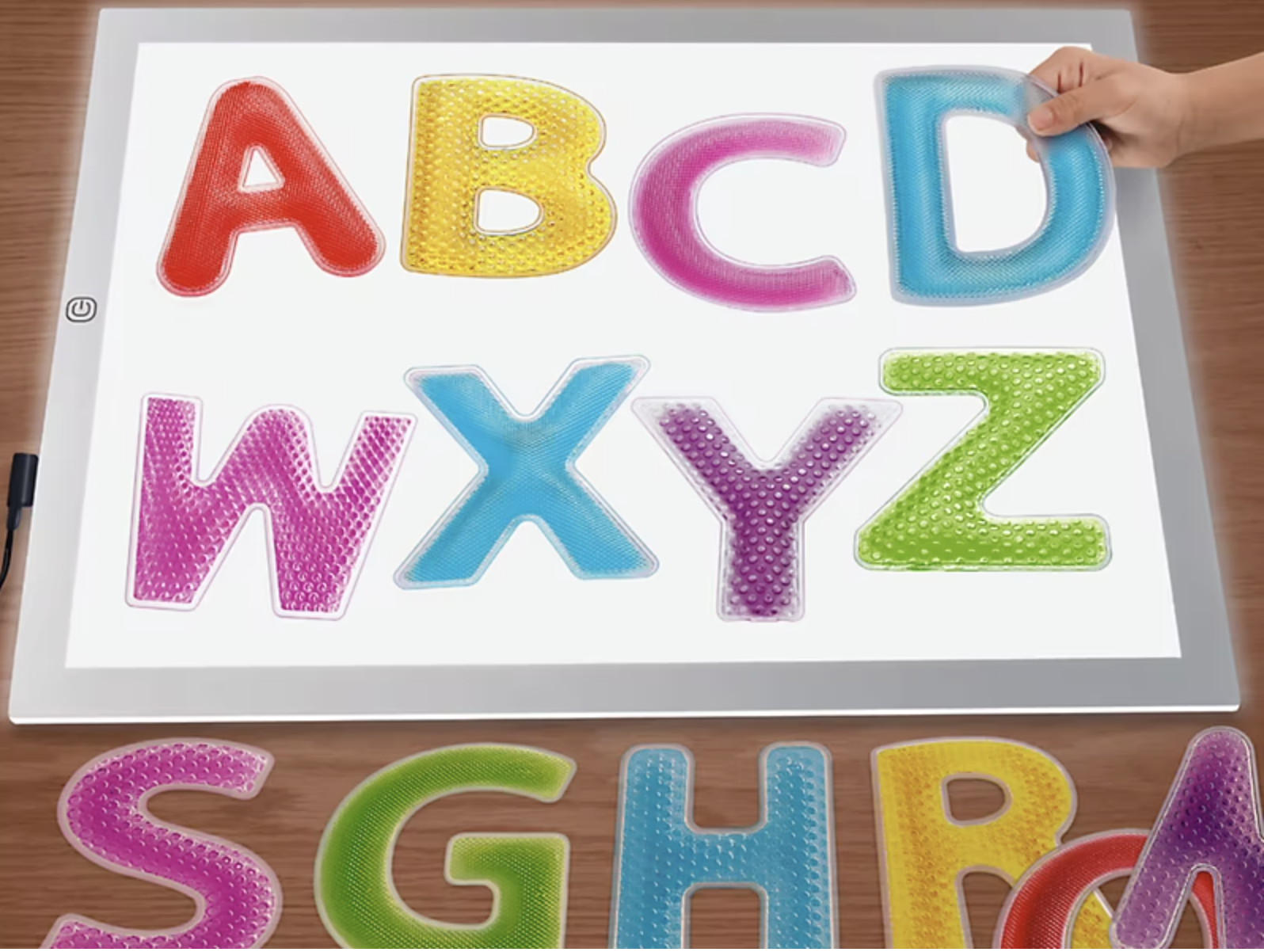
Tactile Liquid Letters-I am in love with this set of letters from LakeShore Learning! I strongly believe that kids learn and retain information better when there is a tactile experience included. These oversized, gel filled letters are not only fun to play and fidget with, they have different textures which is great for sensory seeking kids. They are a great, motivating and very hands on way for kids to learn the letters and there are so many ways you can use them. For example, you can have kids put the alphabet in order, find objects around the house that match the letter, practice spelling out sight words and so much more.
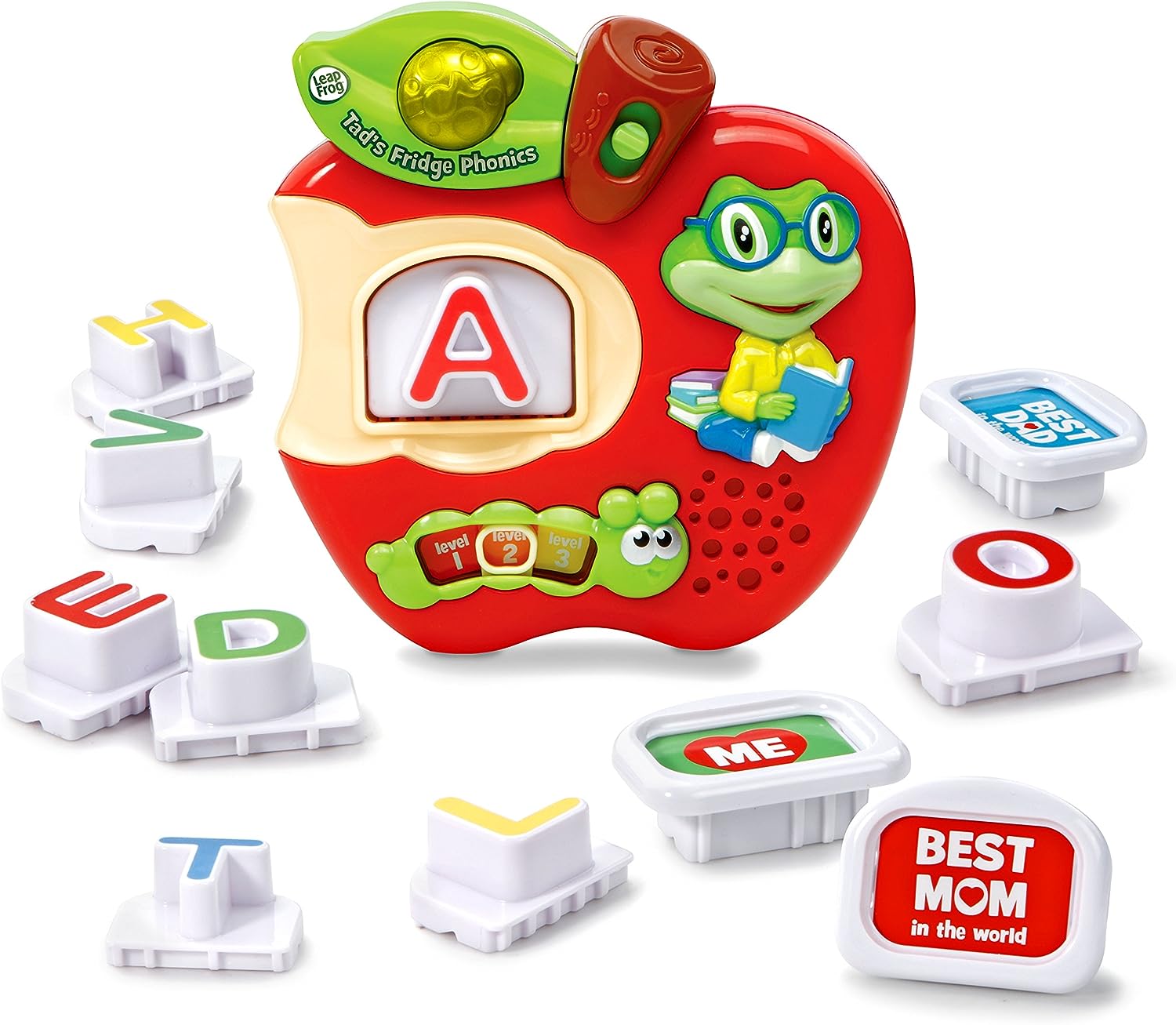
LeapFrog Fridge Alphabet Set-LeapFrog has a lot of really great products that encourage learning and one of my favorites is this magnetic alphabet set for your fridge (or any metal surface). There are 3 modes of play that reinforce letter names, phonics and word skills. The set comes with 26 uppercase letter tiles that fit into the magnetic base and once they are put in place, it will tell you the letter name or sound. Not only is this great for learning letters, it’s a great toy to work on improving fine motor, grasping and manipulation skills and improves motor planning and hand-eye coordination,

Alphabet Play Block Set-this set of gorgeous alphabet blocks is what I consider an investment pieces because it has a pretty hefty price tag but totally worth it, especially if you have multiple children. I have used this gorgeous set with so many kids at work and it’s so fun to see them play with it. The set comes with 26 wooden letters and then matching block pieces that you build onto the letter to make something that starts with that letter. For example, V has two pieces that you attach to it to turn it into a volcano. It also comes with a book with the letters and pictures of what each letter will turn into which is good for working on improving visual motor skills such as visual attention, visual discrimination and visual scanning skills. Not only will children learn their uppercase letters, they will work on improving fine motor, grasping and manipulation skills and work on improving executive functioning skills such as focus, attention, organizational skills and improving frustration tolerance.
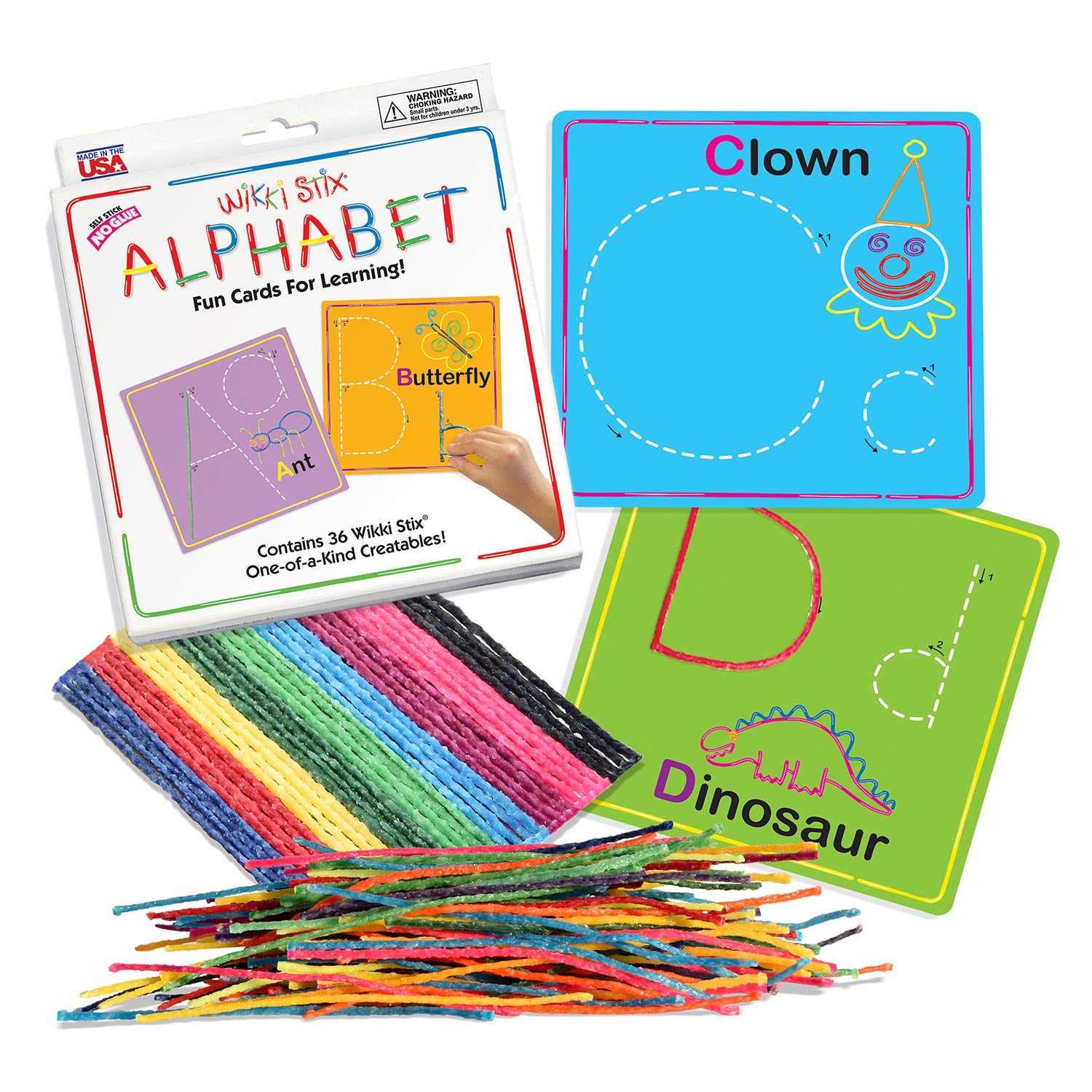
Wikki-Stix Alphabet Set-I have been using WikkiStix for years and have put them on my gift guide for years because of their versatility. They are a great sensory tool and can keep kids entertained for hours. I have used them as a way to learn how to write letters and then fell in love with this set when I discovered it. The set comes with 26 colorful cards that the Wikki Stix stick to, a blank practice card and 36 colored Wikki Stix. Each of the cards has an upper and lowercase letter and an illustration to go along with it that kids can copy with their Wikki Stix if they want. The nice thing about the cards is that they have directional arrows so kids can make the letters correctly. Not only is this a great sensory based way to learn how to make letters, it’s a fun way to work on improving fine motor, grasping and manipulation skills, improves hand-eye and bilateral coordination skills and improves visual motor and visual perceptual skills.
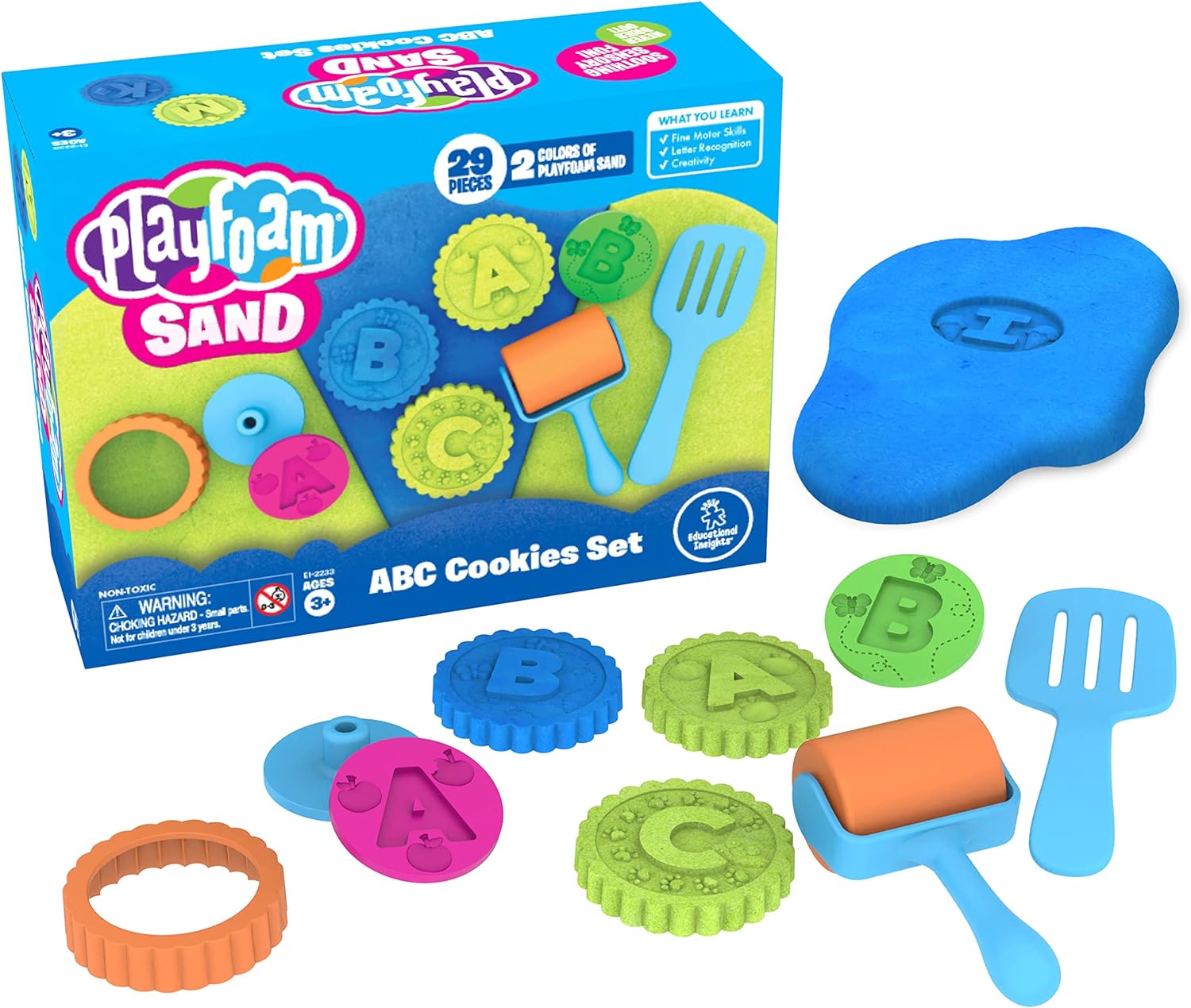
Playfoam Sand ABC Cookies Set-if you have a kid who loves sensory play and needs to practice learning their letters, this is a fun way to do it. PlayFoam Sand is a non-messy, soft and squishy, super stretchy and colorful sensory material that allows for sensory exploration and can be used in a variety of ways. This set comes with two 8-ounce packs of Playfoam Sand, cookie cutter, 26 letter stamps, a spatula and a roller. Use the roller to flatten the sand, use the stamps to make all of the letters and then use the cookie cutter to cut each letter out. This is not only a great way to learn letters, it’s a fantastic way to work on improving fine motor, grasping and manipulation skills, works on improving visual motor, visual perceptual, hand-eye and bilateral coordination skills and works on improving focus and attention.
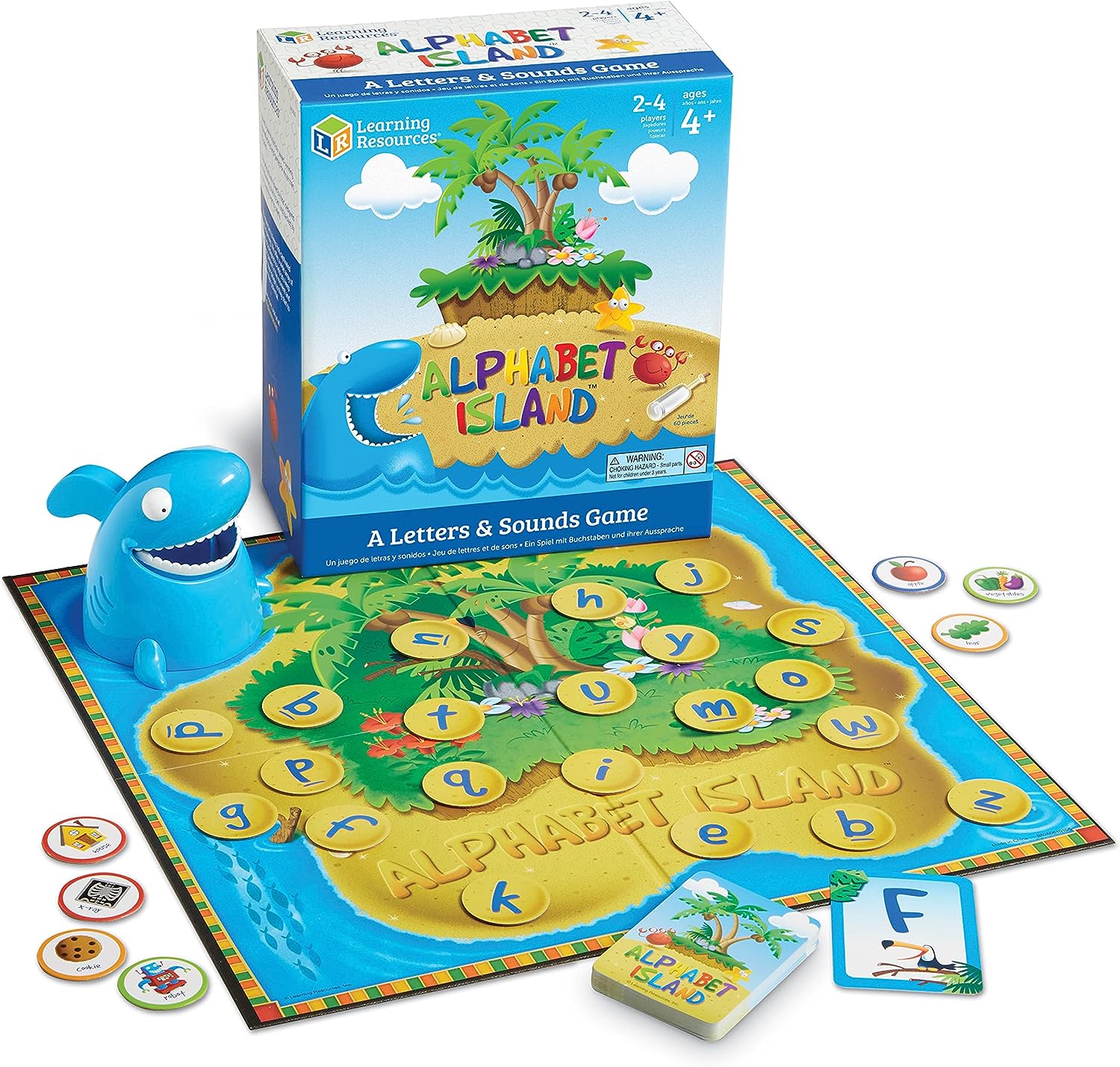
Alphabet Island Letter and Sounds Game-learning is always more fun when you can make a game out of it and if you have a child who is really struggling with learning their letters, you really have to keep it light hearted and as fun as possible. In this game, players race to match upper and lowercase letters without losing a letter from the hungry shark. Whoever collects the most letters is the winner. What’s nice about this particular alphabet game is that it can be made more challenging for kids who have already mastered identifying their letters. If you flip the alphabet discs over, there is a picture on each side that corresponds with the letter.
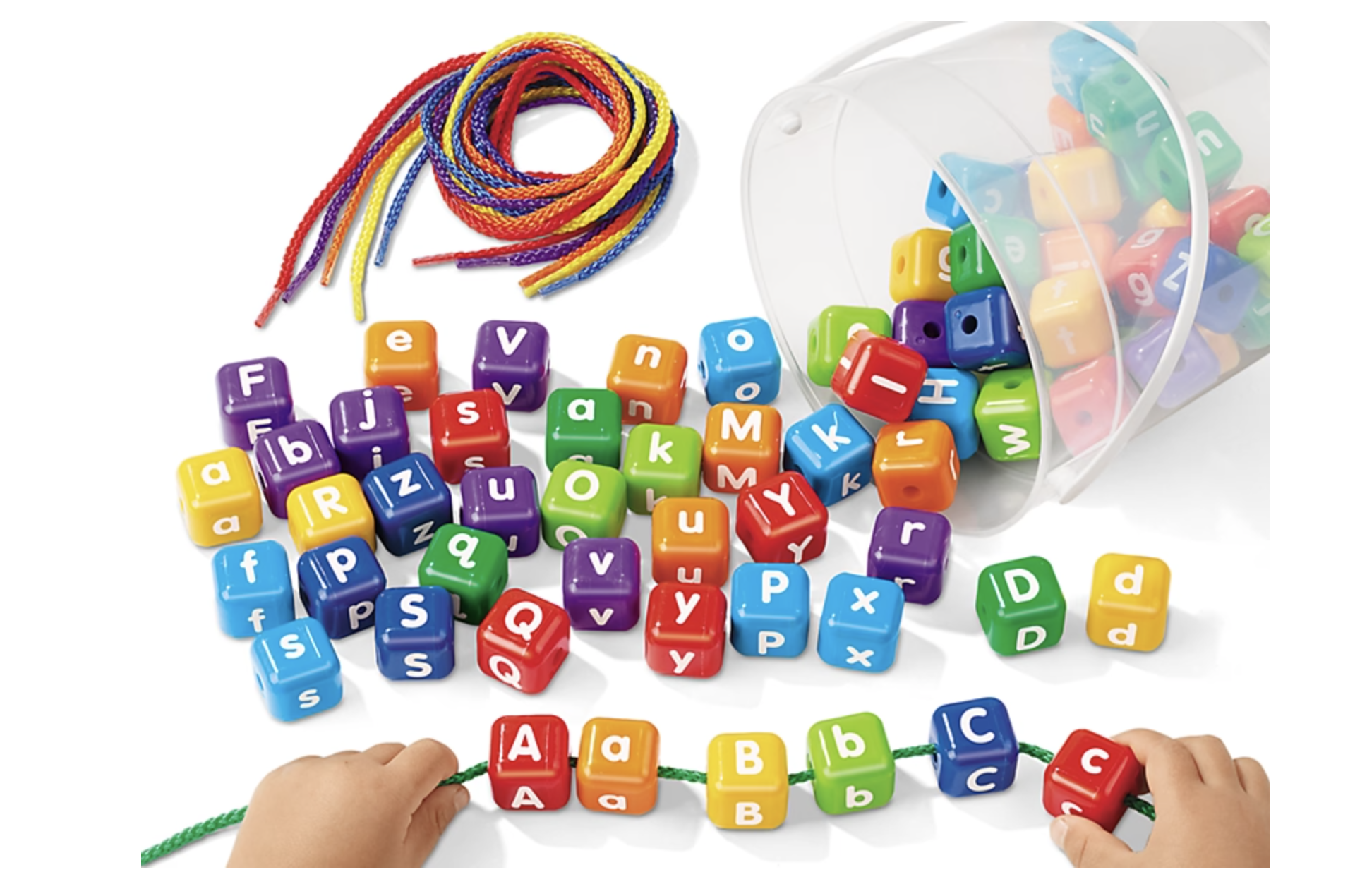
Giant Alphabet Beads-this is a super easy way to work on learning the letters of the alphabet and there are a bunch of easy activities you can do with these upper and lowercase letter beads. You can start simple by having your child find and string the letters in order. As kids get older and are working on reading and have sight words, you can have them use the beads to spell out the words. Not only are these beads a great way to learn how to identify letters, it’s fantastic for improving fine motor, grasping and manipulation skills, encourages bilateral and hand-eye coordination and improves visual motor and visual perceptual skills. An added bonus, beads are a great on-the-go activity to keep kids busy while traveling, waiting for an appointment or while at a restaurant.
Activities for Learning/Writing Letters
- Take a cookie sheet or baking pan and fill with a layer of sprinkles. Using a paintbrush or your finger, form a letter and have your child tell you what it is. Again, once they know all their letters, you can have them practice writing the letters in the sprinkles. I encourage having a child use a paintbrush so they are also working on developing fine motor and grasping skills.
- Make alphabet cookies using cookie cutters.
- Something I did a lot with my kids during Covid and remote therapy sessions was to use Magna-Tiles to form letters of the alphabet. You can print out these templates directly from the Magna-Tile website and they give you visual instructions on how to make all the upper and lowercase letters using different shaped tiles.
- Do an alphabet scavenger hunt around your house/apartment. This could be a fun thing to do during the cold, winter weather and a great way to keep kids occupied without having them on screens.
- When in the bathtub, use shaving cream and make the letters in the shaving cream and have your child tell you what the letter is. Once your child knows all his/her letters, you can have them practice writing the letters in the shaving cream.
iPad Apps for Learning/Writing Letters
While technology isn’t for everyone, I have had a great deal of success motivating some of my kids by using educational apps. It’s important to note that I don’t ever do just an app when I use the iPad with my kids at work. If we are working on learning letters, I will then do a puzzle or some kind of hands-on activity immediately following in order to help generalize what they have learned. Also, I like the handwriting apps because kids are not able to make the letters incorrectly and they learn that more naturally and with less verbal prompting because the app just won’t let them. move on until they make the letter the correct way. When using handwriting apps with my kids, I always use a stylus (my favorite is the Cosmonaut) and again, follow up by having kids practice writing the letters with pencil and paper. Here are some of my favorite alphabet and handwriting apps:
- Endless Learning Academy-this is a pricey subscription app but worth every penny. There are several games and activities built into the one app and it not only has games that teach the letters of the alphabet and games for learning how to write the letters, it’s got games that encourage reading, math, drawing and so much more.
- AlphaTots Alphabet-this interactive app has 26 puzzles and mini-games to help kids learn the upper and lowercase letters of the alphabet. Includes an engaging alphabet sing-a-long song that helps kids recite their ABCs.
- Avokiddo ABC Ride-kids have fun learning their letters by solving fun puzzles and finding hidden letters for all 26 letters of the alphabet. They can choose which character they want to go on their biking adventure as they learn their letters, work on letter matching skills and so much more. One of the things I like most about about this app is that it gives you the choice of going through the alphabet in alphabetical or random order.
- Metamorphabet-this is another interactive, engaging and motivating app that helps kids learn their alphabet. Kids poke, drag, tap and move the letter around the screen to see it morph into a handful of fun images.
- LetterSchool-this is one of my absolute favorite handwriting apps and use it almost daily in my therapy sessions. There are a lot of aspects of this app that I love including the fact that it is 3-step process for each letter: tap, trace and write. What’s great about practicing on an app first is that it will not allow you to make the letter incorrectly so kids learn to correct themselves on their own. When I first began using LetterSchool, it was only for learning letters, numbers and some simple shapes, but it has grown significantly and can work on reading and so much more now.

